

Learn English with ESL Videos and Lessons - Real English is a Registered Trademark of The Marzio School. All The Videos (with & without lessons) Lesson 1 - Hi!
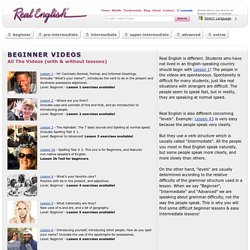
Contrasts Normal, Formal, and Informal Greetings. Includes "What's your name? ", introduces the verb to be in the present and illustrates possessive adjectives. Level: Beginner - Lesson 1 exercises available! Lesson 2 - Where are you from? Lesson 3 - The Alphabet: The 7 basic sounds and Spelling at normal speed. Lesson 3b - Spelling Test # 2. Video in EFL Classrooms - Articles. Language Levels. What do the terms beginner, intermediate, and advanced really mean?
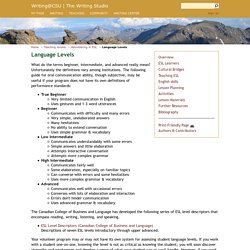
Unfortunately the definitions vary among institutions. The following guide for oral communication ability, though subjective, may be useful if your program does not have its own definitions of performance standards: The Canadian College of Business and Language has developed the following series of ESL level descriptors that encompass reading, writing, listening, and speaking.
ESL Level Descriptors (Canadian College of Business and Language) Descriptions of seven ESL levels introductory through upper advanced. Your volunteer program may or may not have its own system for assessing student language levels. Sample Intake Test Sample interview test for oral communication ability from International Students Inc. at Colorado State University; used by permission. The tenses and aspects of English. Dr.
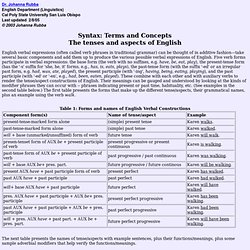
Johanna RubbaEnglish Department (Linguistics)Cal Poly State University San Luis ObispoLast updated 2/8/05© 2003 Johanna Rubba Syntax: Terms and Concepts The tenses and aspects of English English verbal expressions (often called verb phrases in traditional grammar) can be thought of in additive fashion—take several basic components and add them up to produce the various possible verbal expressions of English. Five verb forms participate in verbal expressions: the base form (the verb with no suffixes, e.g. have, be, eat, play), the present-tense form (has the '-s' suffix for 'she, he, it' forms, e.g., has, is, eats, plays), the past-tense form (with the suffix '-ed' or an irregular past form, e.g. had, was, ate, played), the present participle (with '-ing', having, being, eating, playing), and the past participle (with '-ed' or '-en', e.g., had, been, eaten, played).
Using DVD and video in your ESL class. In part one of this article, we suggested some ideas using very short extracts from movies to present and practise new language, and develop communicative skills.
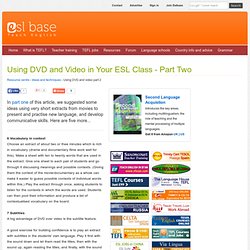
Here are five more... 6 Vocabulary in context Choose an extract of about two or thee minutes which is rich in vocabulary (drama and documentary films work well for this). Make a sheet with ten to twenty words that are used in the extract. Give one sheet to each pair of students and go through it discussing meanings and possible contexts. (Giving them the context of the movie/documentary as a whole can make it easier to guess possible contexts of individual words within this.) 7 Subtitles A big advantage of DVD over video is the subtitle feature.
A good exercise for building confidence is to play an extract with subtitles in the students' own language. As reading practice for higher level students, use an extract with subtitles in English. 8 The news Record the TV news and choose an item with a lot of visual footage. Comments. Using DVD and video in ESL teaching. Have you ever wondered how to use movies in your ESL classes, without just sitting your students down in front of the screen, hitting "Play" and sitting back to watch (which, let's face it, they could do at home)?
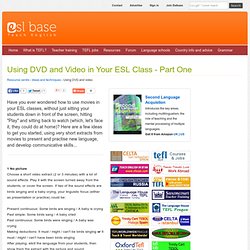
Here are a few ideas to get you started, using very short extracts from movies to present and practise new language, and develop communicative skills... 1 No picture Choose a short video extract (2 or 3 minutes) with a lot of sound effects. Play it with the screen turned away from the students, or cover the screen. TEFL LARGE CLASSES. Your strategies for large classes - Teaching ESL - eslHQ. Hi Ralph, and thanks for your message!!

I-to-i Chalkboard « Keywords: i-to-i, teaching large classes, TEFL, TESOL. Teaching English is a challenge, teaching large classes is the challenge of all challenges!
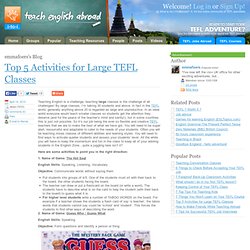
By large classes, I’m talking 30 students and above. In fact in the TEFL world, generally anything above 20 is regarded as large and unproductive. In an ideal world everyone would teach smaller classes so students get the attention they deserve (and for the peace of the teacher’s mind and sanity!) , but in some countries this is just not possible. So it’s our job being the ever so flexible and creative TEFL teachers that we are to make the best of what we have got.
Character traits lesson. Improving Character Adjectives Vocabulary - Vocabulary Lessons for ESL Students. Does anyone know some good activities for large classes? Hi, I teach very large classes as well, often with a massive range of levels, both in interest and ability.

I find that most of the whispering or relay games work really well with large groups because the more teams you have the stronger the competition. 1) For low level students line them up in teams of 5 or 6. Give the last student in each row the same word, and have them whisper it up to the front. The first class to either write the word on the board or tell it to the teacher wins. It forces kids to both speak clearly and listen carefully, as well as pay attention to that day's key phrases.
For higher levels you can do a relay with a sentence. You can vary this game again by giving them a word to spell. 2) My favorite game of all though is the "Snap" game. Put the students in pairs and lay out a set of flashcards between them that represent the key concepts of that unit. Three ESL Activities for Large Classes. Even the most well prepared lesson plan can fail with a class the size of a small army.
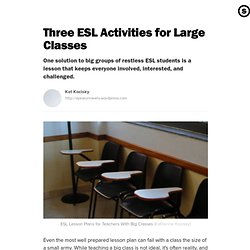
While teaching a big class is not ideal, it's often reality, and when planning activities for class, it's necessary for teachers to consider effective activities for large groups. The following ideas will not always substitute a full lesson plan, but may act as filler activities that can supplement a base lesson or unit of study. Continue the Story ESL Activity for Big Classes. Activities for your first lesson. Getting to know your class A tried and tested opener for learning everyone's name on day one is to get the class to stand in a circle, throw a small ball to one of your students and say your first name as you throw it.

The person who catches it throws it to another person and says their first name. This continues until everyone has said their name a number of times. Your First Lesson: 5 Essential Ice-Breakers That Guarantee Success. Teaching Large Classes. Most teachers agree that teaching a small group of students is easier, more enjoyable, and less time consuming than teaching a large group. Unfortunately, due to budgets, space, or lack of teachers, many ESL schools only offer large classes. Comments and Corrections for Lesson Plan. Lesson plan HELP? Anonymous: Hi everyone, I reallt don't understand what my eacher means with his comment. I thought I did really good. Can anyone check this for me please.. Prepare a plan for a 45-minute lesson on vocabulary of character traits.
TEFL LIMITED RESOURCES. Lesson Plan 6 in the Kitchen. TEFL Resources. T.W.E: Useful TEFL / TESOL Links for ESL Teachers. Esl movie lesson. TEFL YOUNG LEARNERS.